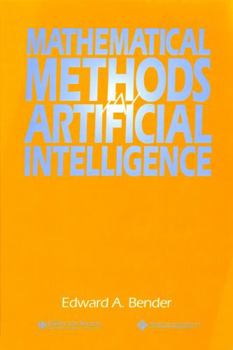Mathematical Methods in Artificial Intelligence
Mathematical Methods in Artificial Intelligence introduces the student to the important mathematical foundations and tools in AI and describes their applications to the design of AI algorithms. This... This description may be from another edition of this product.
Format:Paperback
Language:English
ISBN:0818672005
ISBN13:9780818672002
Release Date:January 1996
Publisher:Wiley-IEEE Computer Society PR
Length:668 Pages
Weight:1.32 lbs.
Dimensions:1.4" x 7.3" x 9.7"
Customer Reviews
4 ratings
Good, but somewhat outdated
Published by Thriftbooks.com User , 16 years ago
This is a good introductory text in the mathematical backgound of AI. It covers the problems of searches, logic programming, different types of reasoning, neural networks as well as a little bit of probabilities. Its great merit consists in the fact that it is not disconnected from the realities of the world. The chapters in Prolog, for instance, are well developed and the mathematical foundation of this programming language is quite thoroughly explained. This is rare to find in Prolog or logic books; most of them are either too pragmatic or too theoretical. This book makes a nice balance between the two. The book has some drawbacks, though. First and foremost, it is geared a little bit to much on logic at the expense of other intelligent forms of computing (pattern recognition - be it vision, speech or handwriting, planning, constraints processing, theorem proving, case-based reasoning, to name just a few). For example, the section dedicated to stochastic processing is ridiculously small. However, as a good introduction into the math of AI, this book lives well up to expectations.
Interesting but content bit disconnected
Published by Thriftbooks.com User , 16 years ago
Most topics are interesting and contribute to an understanding of AI. Only point of confusion is some sections seem more like authors personal issue rather than a connected discussion of AI. Expected more because of the many recommendations for the authors work.
Excellent
Published by Thriftbooks.com User , 21 years ago
Although using only elementary mathematics, and not at all addressing new areas of artificial intelligence, such as inductive logic programming, this book gives an excellent overview of how mathematics is used in artificial intelligence. Mathematics at all levels is used in this field, both in the algorithms and in discussing its foundations, and this book serves as a good introduction to its application in A.I. Only elementary algebra and calculus are used in the book, making it very accessible to the beginning student in computer science. Readers with more sophisticated background in mathematics can then extend the results in the book to more advanced mathematical contexts. The author's writing style is very informal, and in many places in the book he encourages the reader to "stop and think" before continuing in the reading. Exercises, some simple and some very challenging, are found at the end of most chapter sections. The author gives a brief overview of the history of A.I. in chapter one, including a discussion of the issues of computational complexity in A.I. algorithms, a discussion of expert systems (with examples), and a few biographical sketches. Chapter 2 is a fairly detailed overview of search algorithms, and the author introduces some notions from the mathematical field of combinatorics, namely directed graphs and ordered trees. Induction and recursion are then reviewed as tools for search algorithms. The recursive formulation of algorithms in A.I. is of course very powerful, and one that students need to master early on. Fields such as bioinformatics and data mining are becoming increasingly dependent on search algorithms from A.I., and the author reviews these in detail, including 'simple' search methods such as breadth-first, depth-first, and iterative-deepening, along with 'heuristic' methods. The reader gets introduced to first-order predicate calculus in chapter 3. This topic could be said to be one of the most important ones in A.I., and it is discussed in this chapter using the (declarative) programming language Prolog. One could easily use the language Lisp, but Prolog makes more apparent the head/body clause structure of predicate logic. In addition, if a reader wants to move on to more modern developments in A.I., such as inductive logic programming, which can be viewed essentially as predicate logic but with inductive reasoning, a mastery of the content of this chapter is essential. Chapter 4 introduces the reader to the proof theory, namely the technique of resolution, which is discussed for propositional calculus, where it is very simple, and for predicate logic, in the latter wherein some specialized techniques must be brought in, such as Skolemization. The author also discussed proof in the context of Prolog, and introduces the cut operator, which inhibits Prolog from fully implementing resolution. He also gives an interesting discussion on the problem of negation in Prolog and the closed-world assumption. The
It is a useful book for research oriented readers.
Published by Thriftbooks.com User , 24 years ago
Most AI books do not emphasize the mathematical issues. Consequently, the readers face difficulty to read journals. This is a highly recommended book for those research oriented readers. It requires no formal background of mathematics beyond high school level. I read the book several times. It helped me a lot to understand many difficult papers. Among the chapters the most useful are chapter 6 on nonmonotonic reasoning and chapter 8 on Bayesian networks. The beginners will find chapter 3 and 4 on predicate logic and the theory of resolution highly useful. I strongly feel that the book should be read by all people working in the domain of AI.





